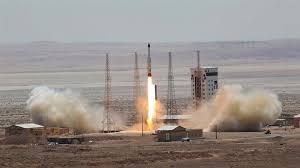US say they fear long-range ballistic technology used to put satellites into orbit could also be used to launch nuclear warheads
Iran claimed on Wednesday that it had successfully launched its first-ever military satellite into orbit in a move that experts described as a significant but not game-changing achievement.
Iran’s Revolutionary Guard claimed it had launched the Nur satellite, which experts suggest could serve as a surveillance tool, into orbit 425 kilometres above the earth’s surface early this morning by firing the two-stage Qassed rocket into space.
“The successful launch of this satellite has brought a new dimension to the defence [capabilities] of the Islamic Republic of Iran,” Maj Gen Hassan Salami, chief of Iran’s Revolutionary Guard, was quoted as saying by official media. “By the grace of God, the Revolutionary Guard became a space power today.”
None of the claims about the satellite launch have yet been independently verified or refuted. The satellite’s functions remain unclear. Experts say its relatively low orbit suggests it will serve as a surveillance beacon. But any imagery it captures will likely be inferior to those provided by numerous private-sector firms.
“It’s a low earth-orbit satellite,” said Markus Schiller, a military and space analyst at ST Analytics, a Munich firm. “It’s not in a position to get better imagery than commercial satellites.”
The Vienna-based United Nations Office for Outer Space Affairs, which tracks objects orbiting the earth, has yet to record the launch.
In the past, Iran has admitted unsuccessful attempts to fire satellites into orbit. But Iranian hardliners and the Revolutionary Guard have also repeatedly fabricated accomplishments, including by doctoring photos. The Revolutionary Guard this month presented an apparent toy it claimed could detect infections of the novel coronavirus “within five seconds.”
Iran and the United States are locked in an escalating confrontation, with the administration of President Donald Trump pursuing a policy of “maximum pressure” against Tehran over its nuclear programme, support for armed allies throughout the Middle East and refinement of its missile technology.
Iran’s communications minister on Twitter emphasised the “peaceful” and defensive nature of Iran’s space programme.
While few Western defence specialists worry about Iran’s satellite surveillance and communications technology, such satellite launches are seen by the US and nonproliferation experts as potential attempts to refine intercontinental ballistic missile technology, including for possible delivery of nuclear warheads.
Iranian Revolutionary Guard commander Brig Gen Amir-Ali Hajizadeh hailed the launch of the solid-fueled rocket as “different from previous ones,” using “non-metallic composite materials” suitable for space.
“Only superpowers have such capability and the rest are just users of such technology,” he claimed.
But Mr Schiller said the two-stage rocket he saw used in Wednesday’s launch – utilising a modified Safir rocket Iran has long had – showed little in the way of new Iranian capabilities.
“The stack is way too weak to reach the United States or even Europe,” he said. “The Iranians can learn some lessons from the launch, but it’s not a new danger.”
The Independent
 Lebanese Ministry of Information
Lebanese Ministry of Information



